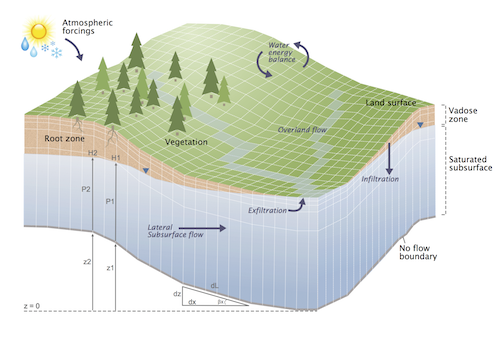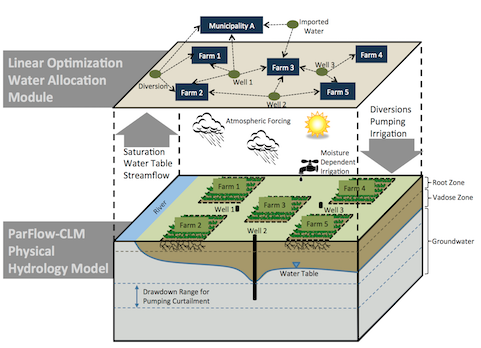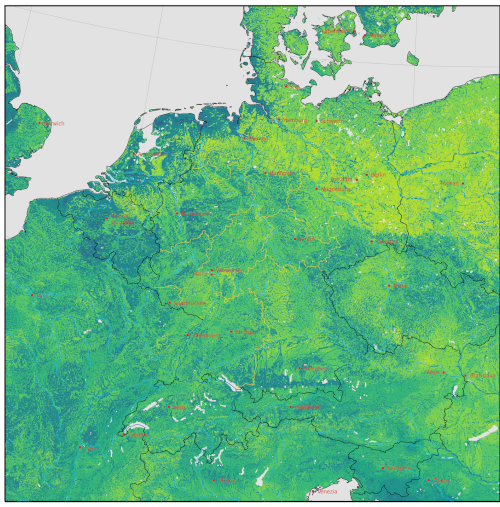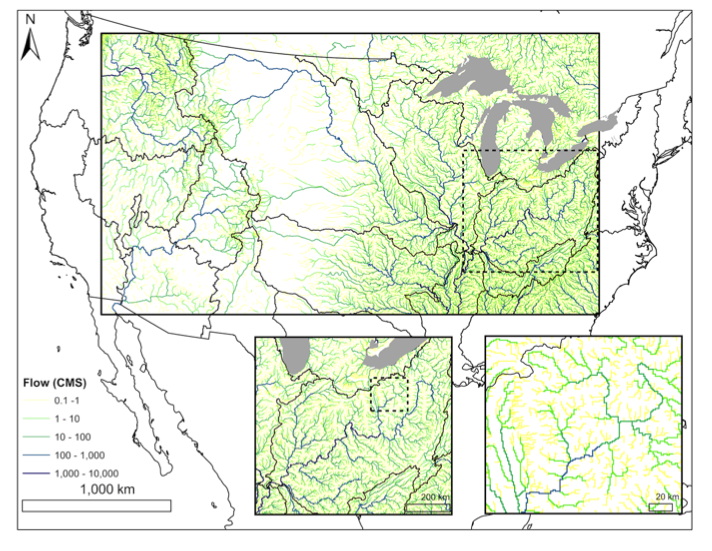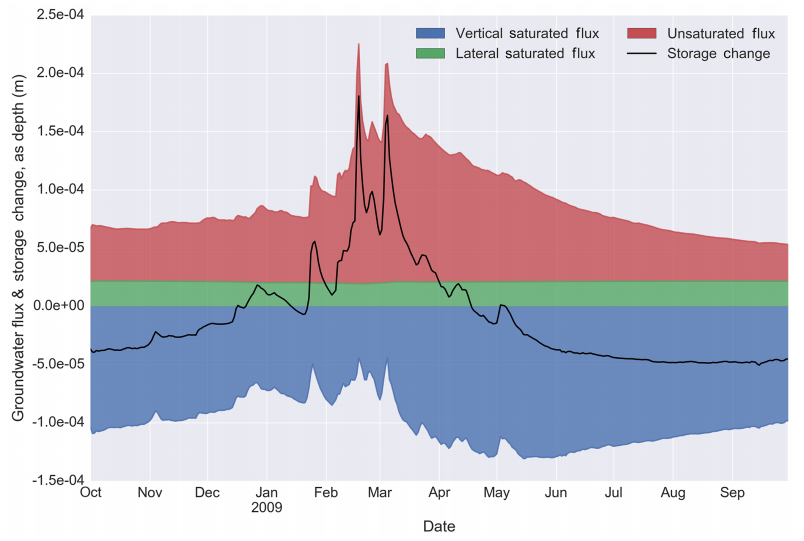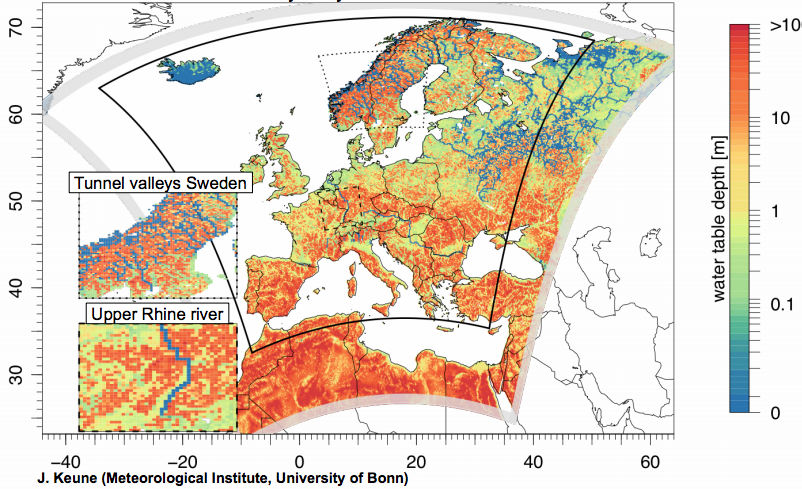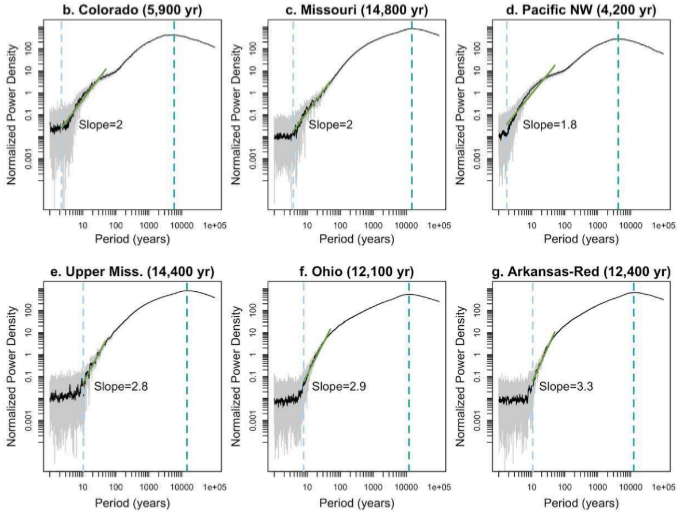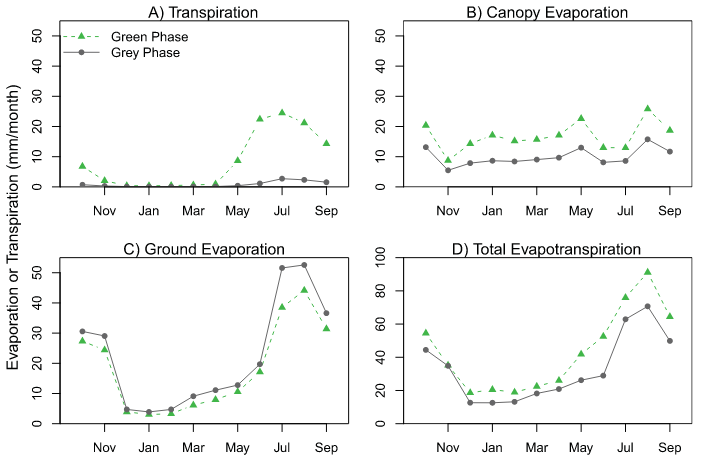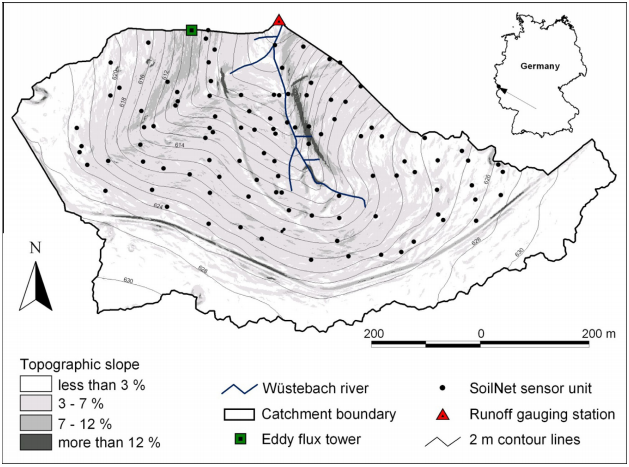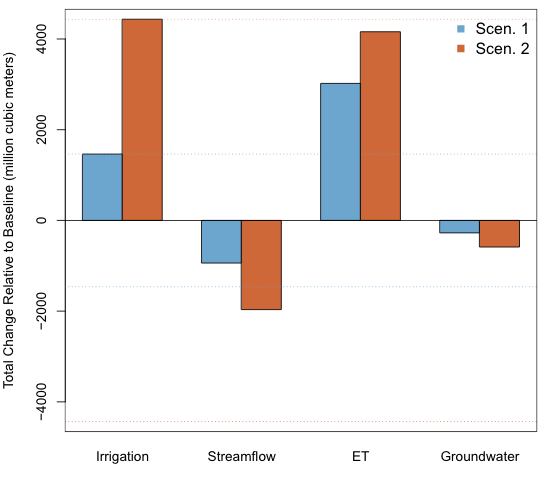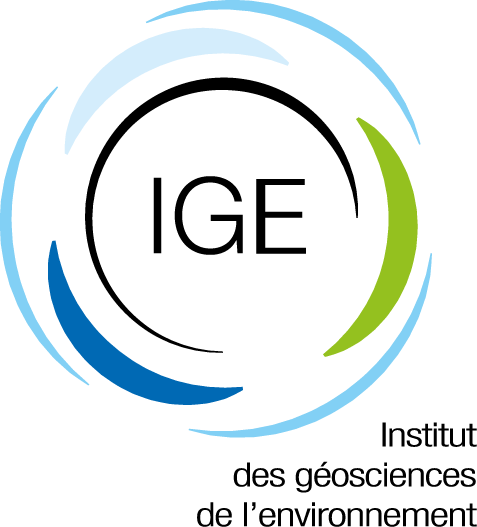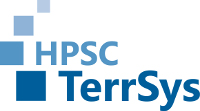Legal Notice
The ParFlow website is a joint effort of the institutions mentioned in the Team section. The ParFlow website is hosted and maintained at the Forschungszentrum Jülich GmbH through the Institute of Bio- and Geosciences (IBG-3, Agrosphere) as part of the Competence Centre for High-Performance Scientific Computing in Terrestrial Systems (HPSC TerrSys), an initiative of Geoverbund ABC/J, which is a cooperation between RWTH Aachen University (Rheinisch-Westfälische Technische Hochschule Aachen), University Bonn (Rheinische Friedrich-Wilhelms-Universität Bonn), University of Cologne, and Forschungszentrum Jülich GmbH. The Competence Centre HPSC TerrSys is located at Forschungszentrum Jülich.
Centre for High-Performance Scientific Computing in Terrestrial Systems (HPSC TerrSys)
Forschungszentrum Jülich GmbH
52425 Jülich
Germany
phone: +49 2461 61-4462
fax: +49 2461 61-2518
e-mail: h.hendricks-franssen@fz-juelich.de
Contact
- Prof. Dr. Stefan Kollet
- Prof. Dr. Harrie-Jan Hendricks-Franssen (Scientific Director HPSC TerrSys)
- Dr. Klaus Goergen
- Niklas Wagner (website maintainer)
The website of HPSC TerrSys is operated by Forschungszentrum Jülich
Forschungszentrum Jülich GmbH
Wilhelm-Johnen-Straße
52428 Jülich
Postal address:
52425 Jülich
Delivery address:
Leo-Brandt-Straße
52428 Jülich
Entered in the Commercial Register of the District Court of Düren, Germany: No. HR B 3498
Value Added Tax ID No. in accordance with § 27 a of the German VAT Law (Umsatzsteuergesetz): DE 122624631
Tax No.: 213/5700/0033
Board of Directors
- Prof. Dr.-Ing. Wolfgang Marquardt (Chairman of the Board of Directors)
- Karsten Beneke (Vice-Chairman)
- Dr. Astrid Lambrecht
- Prof. Dr. Frauke Melchior
Supervisory Board
Ministerialdirektor Volker Rieke
Responsible in the sense of § 18, Abs. 2, Medienstaatsvertrag (MStV)
Dr. Anne Rothaer
Forschungszentrum Jülich
Leiterin Unternehmenskommunikation
Wilhelm-Johnen-Straße, 52428 Jülich
Contact
General inquiries: +49 2461 61-0
General fax no.: +49 2461 61-8100
Internet: http://www.fz-juelich.de
e-mail: info@fz-juelich.de
Copyright
Copyright and all other rights concerning this website are held by Forschungszentrum Jülich GmbH. Use of the information contained on the website, including excerpts, is permitted for educational, scientific or private purposes, provided the source is quoted (unless otherwise expressly stated on the respective website). Use for commercial purposes is not permitted unless explicit permission has been granted by Forschungszentrum Jülich.
For further information, contact: Corporate Communications
Disclaimer
Contents of the Website of Forschungszentrum Jülich:
The website of Forschungszentrum Jülich has been compiled with due diligence. However, Forschungszentrum Jülich neither guarantees nor accepts liability for the information being up-to-date, complete or accurate.
Links to External Websites:
This website may contain links to external third-party websites. These links to third party sites do not imply approval of their contents. Responsibility for the content of these websites lies solely with the respective provider or operator of the site. Illegal contents were not recognizable at the time of setting the link. We do not accept any liability for the continual accessibility or up-to-dateness, completeness or correctness of the contents of such websites. If we become aware of any infringements of the law, we will remove such links immediately.
Data protection
Data protection declaration
We take the protection of your personal data very seriously and process the data collected when you visit this website in accordance with the latest provisions of data protection law. We neither publish your data nor pass it on to unentitled third parties. In the following declaration we set out what data we collect during your visit to our websites, exactly how it is used and whom you can contact if you have any further questions.
Contact details of the person responsible for processing your data
Dr. Klaus Görgen; Institute of Bio- and Geosciences, Agrosphere (IBG-3); Forschungszentrum Jülich GmbH; 52425 Jülich; Germany; phone: +49 (0) 2461 61-6456; fax: +49 (0) 2461 61-2518; e-mail: k.goergen@fz-juelich.de
Contact details of FZJ's data protection officer
Mr. Frank Rinkens; Forschungszentrum Jülich GmbH; 52425 Jülich; Germany; phone: +49 2461 61-9005; e-mail: DSB@fz-juelich.de
Data collection and analysis
Every time a user accesses a website hosted by Forschungszentrum Jülich GmbH and every time a file is requested, data connected to these processes are stored in a log. These data do not contain personal information; we are unable to trace which user accessed what information. Personal user profiles therefore cannot be created. The data that is saved will be used for statistical purposes only. This information will not be disclosed to third parties.
The webserver provider (Institute of Bio- and Geosciences, Agrosphere) automatically stores information, which your browser automatically sends, in so-called server log files. These are:
- accessed page or name of the retrieved file,
- quantity of data transferred and notification whether access was successful,
- browser type and version,
- operating system used,
- referrer URL (the website from which you visit us),
- anonymised IP address,
- date and time of server request.
This data cannot be attributed to specific persons and is not merged with other data sources. The data is not used for commercial purposes. It merely serves to
- guarantee a smooth connection to the website,
- enable comfortable use of the website,
- guarantee system security and stability.
The data processing described above is based on Article 6 (1), sentence 1f of the EU General Data Protection Regulation (GDPR). Our legitimate interest arises from the above purposes for data collection.
For the statistical evaluation of our website, we use Google Analytics, see below the disclaimer on Google Analytics.
Personal data
As a rule, the use of our website is possible without providing any personal information (e.g. name, address or e-mail address). Where this is collected, it is done exclusively on a voluntary basis and with your consent under Article 6 (1), sentence 1a GDPR. This data will not be transferred to third parties without your express permission and then only for the purposes for which you have notified us. Data is only transferred to authorised state institutions and authorities within the framework of legal information requirements or if we are obliged to do so by a court order.
The data is deleted as soon as it is no longer needed for processing and where there is no legal requirement to store it.
Cookies
Some Internet websites use so-called cookies. These are small text files which are downloaded onto your computer and stored by your browser. They cause no damage to your computer and contain no viruses. They are designed to make our services more user-friendly, efficient and secure.
Most of the cookies we use are so-called "session cookies" which are deleted automatically once you leave our website. Other cookies remain stored on your computer until you delete them. They enable us to recognise your browser on your next visit.
Disclaimer Google Analytics
This website uses Google Analytics, a web analytics service provided by Google, Inc. ("Google"). Google Analytics uses "cookies", which are text files placed on your computer or device to help the website operator analyse how visitors use the site. The information generated by these cookies about your use of this website is usually transmitted to and stored by Google on servers in the USA. On behalf of the operator of this website, Google will use this information for the purpose of evaluating your use of this website, compiling reports on website activity for website operators and providing other services relating to website activity and internet usage.
We use Google Analytics with an activated IP anonymization feature. This means that Google shortens the IP address of users within Member States of the European Union or other signatories to the agreement on the European Economic Area. Only in exceptional cases will the full IP address be transferred to a Google server in the USA and shortened there. Google will not associate your IP address with any other data held by Google. Google may also transfer this information to third parties where required to do so by law, or where such third parties process the information on Google's behalf.
You may refuse the use of cookies by selecting the appropriate settings on your browser; however please note that if you do this you may not be able to use the full functionality of this website. Furthermore you can prevent Google’s collection and use of data (cookies and IP address) by downloading and installing the browser plug-in available under https://tools.google.com/dlpage/gaoptout. By using this website, you consent to the processing of data about you by Google in the manner and for the purposes set out above.
You can prevent the gathering of information by Google Analytics about your visit to this website by clicking on the following link. It will download an opt-out cookie which will prevent the future collection of your information when you visit this website: deactivate Google Analytics.
As a user of this website you hereby acknowledge that the operator of this website, their vicarious agents, their representatives, associated companies, chief executives, managerial staff, employees and their shareholders accept no liability in connection with the obtaining, transmission, processing and analysis of the above-mentioned data for which reason no claims for compensation can be asserted against these natural persons and legal entities.
Your rights
You can
- pursuant to Article 15 GDPR demand information from us about your personal data processed by us. In particular about the purposes of the processing, the categories of personal data concerned, the categories of recipients to whom the personal data have been or will be disclosed, the envisaged duration of storage, the source of your data if not collected by us as well as the existence of automated decision-making, including profiling, and if necessary meaningful information about specific details;
- pursuant to Article 16 GDPR demand the immediate rectification of inaccurate personal data and the completion of incomplete personal data stored by us;
- pursuant to Article 17 GDPR demand the erasure of personal data stored by us where processing of this data is not required for exercising the right of freedom of expression and information, for compliance with a legal obligation, for reasons of public interest or for the establishment, exercise or defence of legal claims;
- pursuant to Article 18 GDPR demand the restriction of the processing of your personal data in so far as you contest the accuracy of the data, the processing is unlawful but you oppose the erasure and we no longer need the data but you require them for the establishment, exercise or defence of legal claims or you have lodged an objection to processing pursuant to Article 21 GDPR;
- pursuant to Article 20 GDPR demand the right to receive your personal data which you have provided to us in a structured, commonly-used and machine-readable format or the right to transmit the data to another controller;
- pursuant to Article 7(3) GDPR withdraw your consent. This will result in us no longer being able to process the data based on this consent in future, and
- pursuant to Article 77 GDPR lodge a complaint with a supervisory authority. As a rule, you can apply to the supervisory authority in your habitual place or residence, place or work or our headquarters.
Right to object
If your personal data is processed on the basis of legitimate interests pursuant to Article 6(1), sentence 1f, you have the right pursuant to Article 21 GDPR to object to the processing of your personal data if there are reasons arising from your particular situation or the objection is against direct marketing. In the latter case you have a general right to object which we shall implement without the statement of a particular situation.
If you would like to avail yourself of your right of cancellation or objection, it is sufficient to send an e-mail to k.goergen@fz-juelich.de.
Data security
When you visit our website, we employ the widely used Secure Socket Layer (SSL) procedure in conjunction with the highest level of encryption which your browser supports. This is usually a 256 Bit encryption. If your browser does not support 256 Bit encryption, we revert instead to 128 Bit v3 technology. You can see from the closed symbol in the lower status bar of your browser whether an individual page of our website is being downloaded in encrypted form.
We use appropriate technical and organisational security measures to protect your data against accidental or deliberate manipulation, partial or complete loss, destruction or unauthorised access by third parties. Our security measures are continuously improved in line with technological developments.
Amendments to this data protection declaration
Amendments or adjustments to our data protection declaration will be necessary from time to time for legal and/or organisational reasons. Please note the latest version of our data protection declaration.
